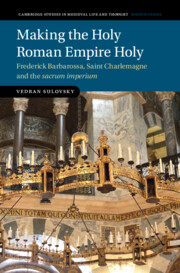 Making the Holy Roman Empire Holy
Making the Holy Roman Empire Holy Book contents
- Making the Holy Roman Empire Holy
- Cambridge Studies in Medieval Life and Thought Fourth Series
- Making the Holy Roman Empire Holy
- Copyright page
- Dedication
- Contents
- Illustrations
- Tables
- Acknowledgements
- Abbreviations
- Introduction
- 1 Sacrum imperium: Lombard Influence and the Sacralisation of the State in the mid-Twelfth Century (1125–1167)
- 2 Sacrum imperium II: The Barometer of Lombard Influence at Court (1167–1190 and Beyond)
- 3 The Cult of Charlemagne from His Death to the Accession of Frederick Barbarossa (814–1152)
- 4 The Canonisation of Charlemagne in 1165
- 5 The Barbarossaleuchter: Imperial Monument and Pious Donation
- 6 The Reliquary Shrine of Saint Charlemagne: The High Point of the Sacrum imperium?
- Conclusion
- Appendix The Decorative Imagery of the Karlsschrein
- Bibliography
- Index
1 - Sacrum imperium: Lombard Influence and the Sacralisation of the State in the mid-Twelfth Century (1125–1167)
Published online by Cambridge University Press: 16 May 2024
- Making the Holy Roman Empire Holy
- Cambridge Studies in Medieval Life and Thought Fourth Series
- Making the Holy Roman Empire Holy
- Copyright page
- Dedication
- Contents
- Illustrations
- Tables
- Acknowledgements
- Abbreviations
- Introduction
- 1 Sacrum imperium: Lombard Influence and the Sacralisation of the State in the mid-Twelfth Century (1125–1167)
- 2 Sacrum imperium II: The Barometer of Lombard Influence at Court (1167–1190 and Beyond)
- 3 The Cult of Charlemagne from His Death to the Accession of Frederick Barbarossa (814–1152)
- 4 The Canonisation of Charlemagne in 1165
- 5 The Barbarossaleuchter: Imperial Monument and Pious Donation
- 6 The Reliquary Shrine of Saint Charlemagne: The High Point of the Sacrum imperium?
- Conclusion
- Appendix The Decorative Imagery of the Karlsschrein
- Bibliography
- Index
Summary
The first chapter deals with the phrase sacrum imperium in the period 1125–1167. It starts out as a rare occurrence in imperial Italy when the locals sought German imperial assistance and, at the same time, a staple phrase used by Latin diplomats to address the Byzantine emperor. However, Sulovsky shows that after the Second Crusade (1147–1149), the German imperial court increasingly adopted elements of the sacral terminology of the state, as used in the Byzantine east, when dealing with Italian affairs. When Barbarossa’s second Italian campaign (1158–1162) was being planned in early 1157, the term sacrum imperium finally appeared in a document issued by the imperial chancery. However, whereas previous scholars could not tell who the author behind the text was, Sulovsky argues that it was the senior notary Albert of Sponheim, who had introduced other innovations as well, and who had taken part in both the aforementioned crusade and in Frederick’s first Italian expedition as a high-level diplomat. Moreover, Albert adopted sacrum imperium both from the Italian and Byzantine usages to the German one, so that he could convince the letter’s addressee, his fellow crusader Otto of Freising, to join the Italian war.
Keywords
- Type
- Chapter
- Information
- Making the Holy Roman Empire HolyFrederick Barbarossa, Saint Charlemagne and the <i>sacrum imperium</i>, pp. 20 - 76Publisher: Cambridge University PressPrint publication year: 2024
